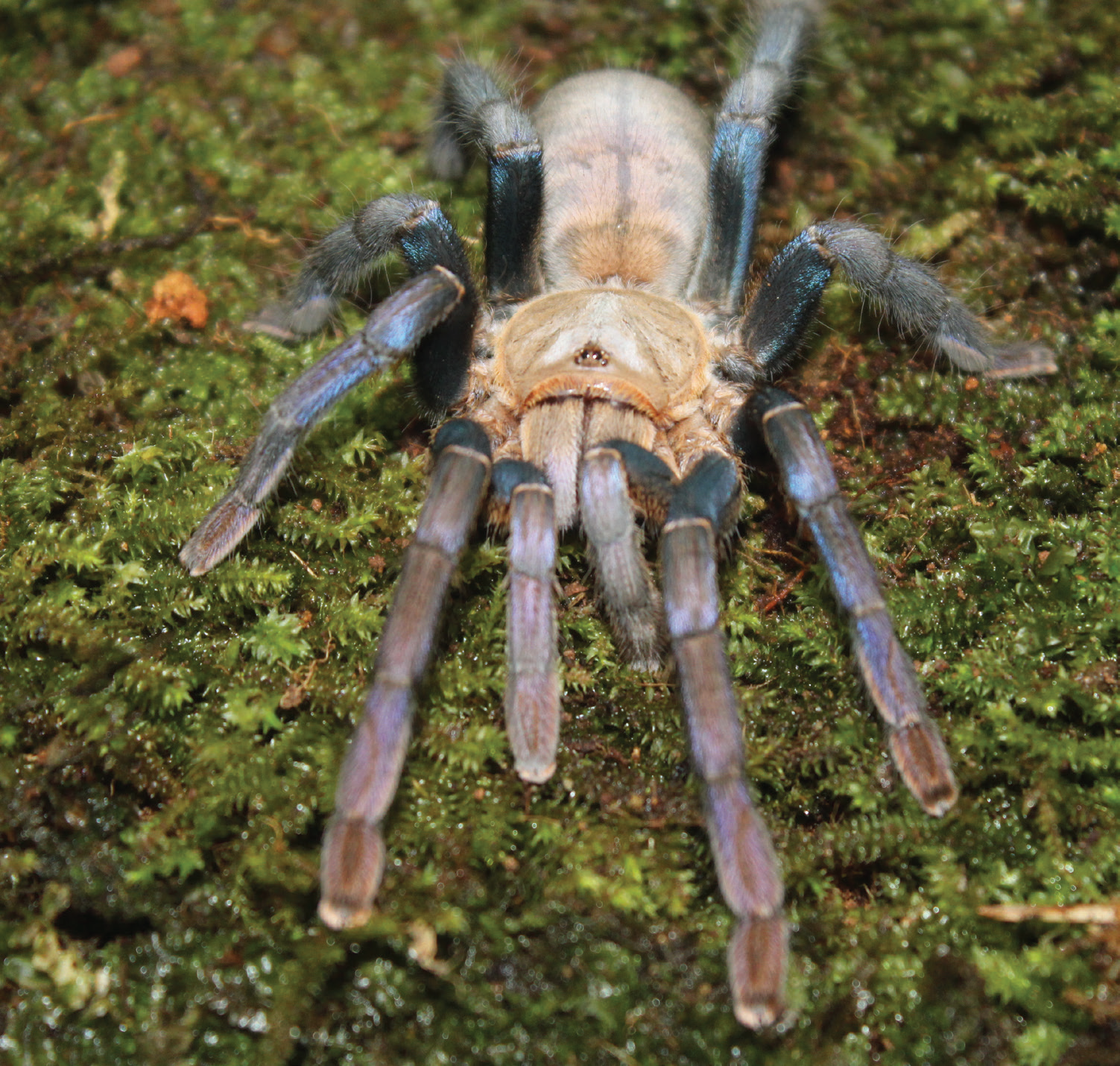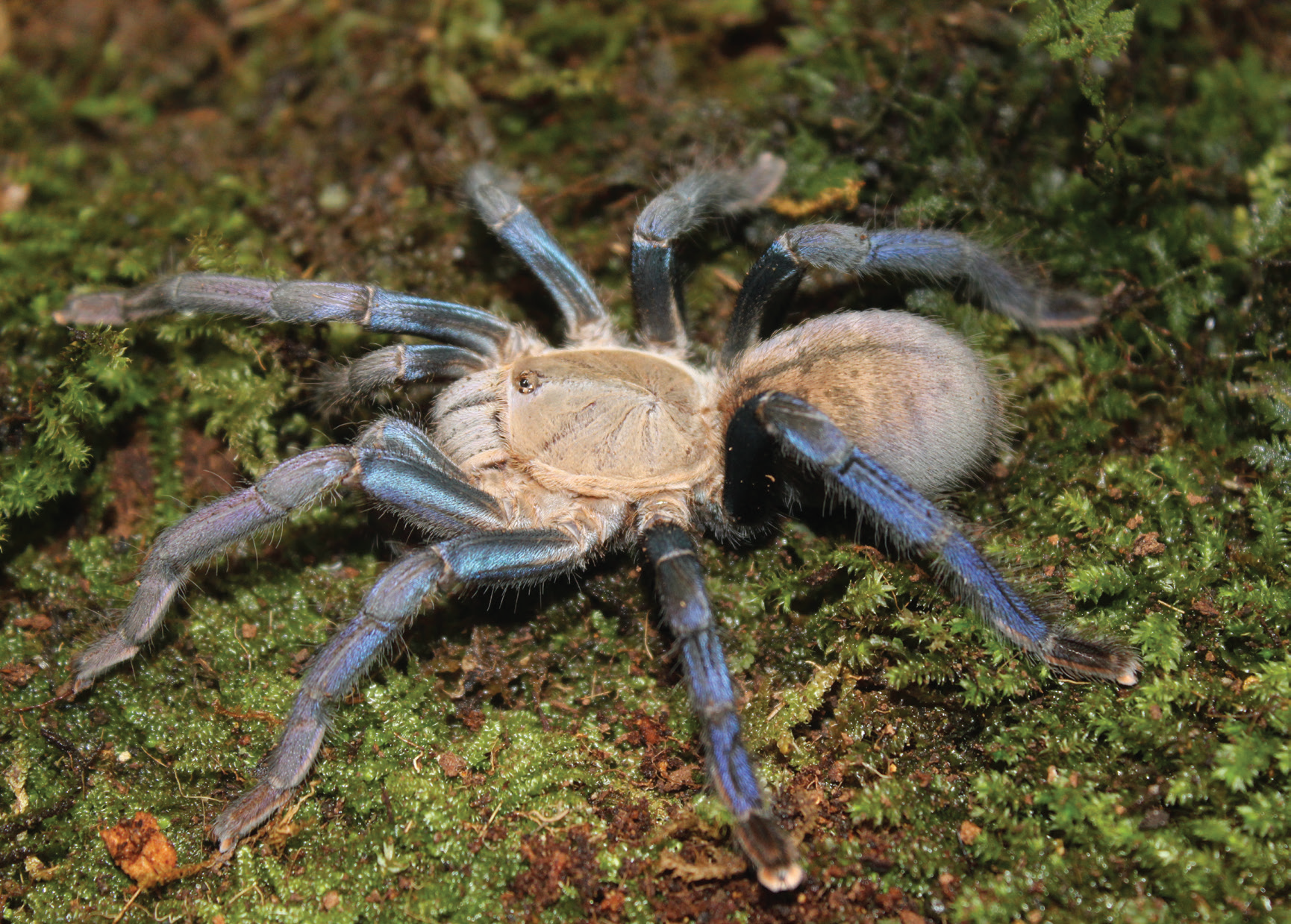The Haplopelma lividum or Cobalt Blue Tarantula
In the invertebrate pet trade, the cobalt blue tarantula—which takes its name from the bright blue color of its legs—is sought after for its striking coloration. Only the females retain this beautiful coloration until adulthood, since the males of this species turn brown on their final molt. This species originated from the rainforests of Myanmar, Thailand, Laos, Cambodia, and Vietnam.
FAST BUT SKITTISH
 The Haplopelma lividum loves to create burrows in substrate. They can create complex channels of burrows that look like a maze if viewed from below. These burrows are lined by webs so that these do not collapse.
The Haplopelma lividum loves to create burrows in substrate. They can create complex channels of burrows that look like a maze if viewed from below. These burrows are lined by webs so that these do not collapse.
Caring for a Haplopelma lividum is just like having a pet hole because it seldom leaves its burrow. They are very fast and are able to hunt at striking speeds. Rehousing can sometimes be a challenge in caring for this tarantula, since rehousing is always necessary especially while the tarantulas are growing. The cobalt blue tarantula can travel short distances in literally the blink of an eye! They are a generally skittish tarantula species, and prefer to hide in the safety of their burrows rather than to bite, but when cornered or prevented from entering their burrows, they will also attempt to bite to ward off predators.
HOME IS WHERE THE BURROW IS
The cobalt blue tarantula prefers to stay hidden in the safety of its complex burrows, so a generous amount of substrate will be necessary in keeping this species to give it a chance to create tunnels. It webs heavily in the enclosure as well; the use of firm structures in the enclosure is all right, provided that care is taken so that these will not fall on the tarantula once it creates burrows or webs. Decorations won’t really be necessary since, being a fossorial [burrowing] species, the H. lividum will only destroy the setup or dig around it.
The minimum acceptable amount of substrate—in the form of cocopeat, organic potting soil or vermiculite—for this species would be 4 inches thick, and it must be moist. Your tarantula will thank you, its own way, if you give it a thicker substrate in its enclosure. If not given enough substrate to dig burrows, the Haplopelma lividum will web heavily in the enclosure until it feels safe and comfortable. An inadequate amount of substrate in the cobalt blue’s enclosure will cause stress to the tarantula.
VENOM CAUTIONS, AND A MEDICAL APPLICATION
In July 2001, there were two separate recorded Haplopelma lividum bite reports in Japan, with both bite locations being on the finger. The cobalt blue tarantula is not native to Japan, and no antivenom is available. After the bite, severe pain and inflammation was experienced by the patients; these lasted several hours.
In one bite report, arthritic stiffness (difficulty in movement) in the joints near the bite location was also experienced for a few weeks following the bite. There was no permanent damage to both of the patients.
It can be concluded that the bite was generally harmless and the patients did not experience any allergic reaction to the venom as well. At the time, the composition of the venom had not yet been scientifically described.
Out of 46,340 species of spiders and tarantulas, only 1,407 species of tarantulas are being studied for their venom, among them the Haplopelma lividum. A 2016 study (during which the chemical composition of the venom was described) revealed that a chemical compound derived from its venom, when injected in rodents, reduced inflammatory and neuropathic pain. This study also showed that the pain relieving effect of Haplopelma lividum venom was better than morphine for neuropathic pain.
As venom is a naturally occurring chemical that can be obtained from animals such as tarantulas and is easily absorbed by the human body, it is very possible to derive certain drugs from tarantula venom in the future. Other arachnid species are also being studied to learn how their venom can be used for applications in humans.
Interview with the Keeper

Animal Scene’s Nyza Ho sat down with experienced tarantula keeper Nico Guiza to learn more about this colorful arachnid. Nico has kept a variety of tarantulas for a long time; he is also a photographer who loves to make enclosure setups and take stunning photos of his pets.
Q: How long have you been caring for tarantulas? How many species of tarantulas do you have right now?
A: I started collecting tarantulas when I was 17 years old, and that’s way back 2011; it was [in my second] semester in college. Well, for now, I’ve got only [a] few species left, about more than 20…and that includes our local tarantulas.
Q: How long were you a tarantula keeper when you decided to get your first cobalt blue tarantula?
A: I bought [my first] cobalt blue tarantula way back April or May 2014, I think. So [I had been a keeper for] more than 2 years when I…bought [a] cobalt blue tarantula.
Q: What got you interested in keeping the cobalt blue tarantula?
A: I was interested because of its beautiful color, and it’s uncommon, so I…decided to buy it as part of my collection. But before I bought this tarantula, I [did research on] it to get ideas on how to take care of [it].
Q:How long have you been keeping your cobalt blue tarantula?
A: I [have] kept [my] cobalt blue tarantula for 32 months.
Q: Describe the enclosure that you have for your cobalt blue tarantula.
A: The height of the enclosure for my cobalt blue is only 8 inches, the width is 6 inches, and the length is 12 inches. But I recommend using a height [of] more than 8 inches for the enclosure. My substrate measures about 5-6 inches in height. I used a mixture of cocopeat, organic soil, and moss for the substrate. I always keep the terrarium moist.
Q: What is the diet of your cobalt blue tarantula?
A: I feed my cobalt blue with super worms, lats, dubia, and orange head roaches. I only feed them once a week or once…every two weeks because I don’t like to power feed my cobalt blue tarantula.
Q: Is the cobalt blue tarantula easy to care for in the Philippines? What do you think is the most important need of cobalt blue tarantulas being cared for in the Philippines?
A: As an [advanced] keeper, [I find that] it is easy to care for [the] cobalt blue tarantula here in Philippines. For me, the [most] important need [of the] cobalt blue tarantula being cared [for] as [a] pet here in Philippines is proper care from its owner or should I say, a responsible owner. Just make sure to give the right enclosure, substrate, food, and moisture. That is pretty much all they need.
Q: Have you ever tried handling your cobalt blue tarantula?
A: I never tried handling my cobalt blue tarantula, and it doesn’t mean that I am afraid [of] handling it, I just don’t want to handle it.
Q: Have you ever been bitten by the cobalt blue tarantula?
A: Nope, and I don’t want to be bitten by it.
Q: What is the safest way to rehouse the cobalt blue tarantula and prevent it from escaping?
A: Well, for me, the safest way to rehouse the cobalt blue tarantula, based on my experience, is that [to use] a big bin [with a] cover with a height of 15 inches. [There] must [be] more space around [to allow for] when I put the enclosure of the cobalt blue tarantula in the bin. Then that would be the time that I will pour the substrate of the enclosure [into] the bin slowly so that the cobalt blue will not [get] stressed or…injured. Instead [of] using my hands to pick up the cobalt blue, I use a small Tupperware [container] to catch it. When I do [this], I only do it [slowly] to avoid sudden [movements that may cause] injuries falseto my tarantula. When it is inside the Tupperware [container], I put it gently [in] its new place.
Q: What are the challenges that you have experienced in keeping the cobalt blue tarantula?
A: None so far, but all tarantulas should be treated with caution
Q: Is this a species that you would recommend for beginners? Why or why not?
A: I do not recommend this [species for] beginners because of its potent venom and [because it] is a fast specie. This specie is only for [advanced] keepers.
Q: Have you ever experienced an escape from your cobalt blue tarantula? If yes, how did you find it?
A: Nope. I always secure the enclosure of my cobalt blue tarantula.
Q: What are the tips that you can share with aspiring cobalt blue tarantula keepers?
A: You need to provide proper care for this specie, and [you should] always be responsible [as a keeper]. And if you want your cobalt blue tarantula to live longer, you should avoid power feeding. Although [the] cobalt blue tarantula is [a] beautiful specie…you [will] rarely see them [at] the surface [of their enclosure]. [Whether yours is a] male or female cobalt blue tarantula, you should treat them with respect so that you can be called a responsible tarantula keeper. And for us fellow [advanced] keepers, let us guide the beginners in this hobby by helping them to learn, not [by] insulting them or giving wrong information. We [should] guide them instead because they will learn from their mistakes.
This appeared in Animal Scene magazine’s June 2017 issue.






